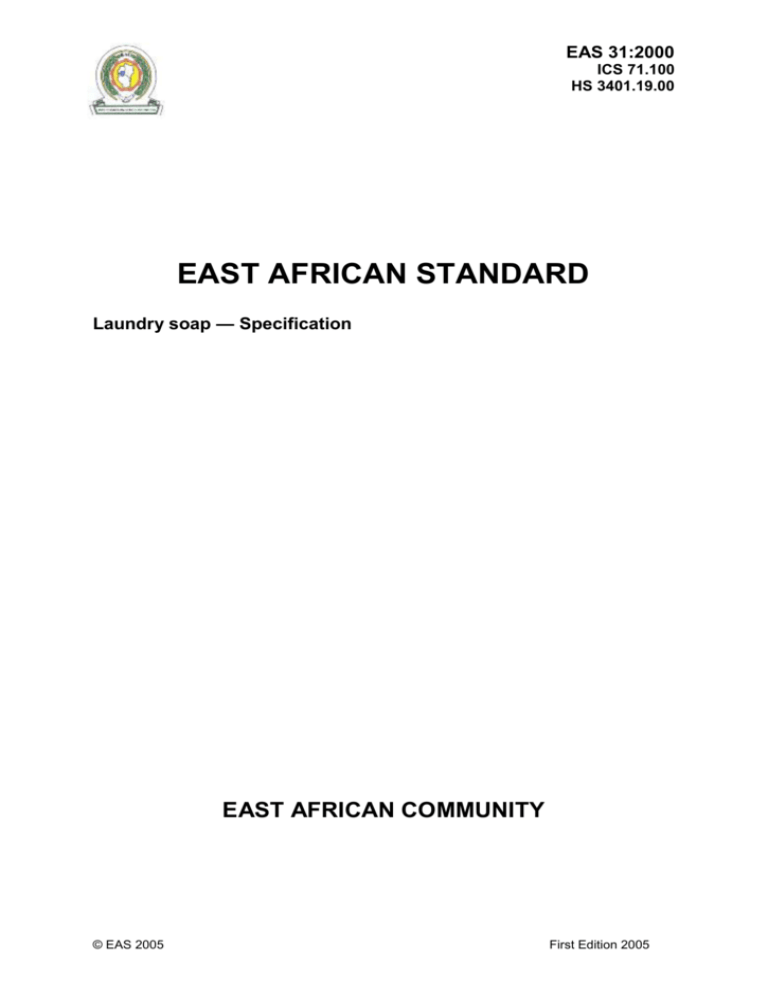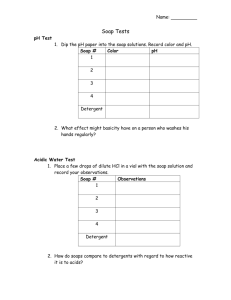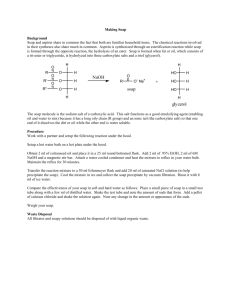
EAS 31:2000
ICS 71.100
HS 3401.19.00
EAST AFRICAN STANDARD
Laundry soap — Specification
EAST AFRICAN COMMUNITY
© EAS 2005
First Edition 2005
EAS 31:2000
Table of contents
Introduction............................................................................................................................................. iv
1
Scope ............................................................................................................................................. 1
2
Definitions ....................................................................................................................................... 1
3
Grades of laundry soap .................................................................................................................. 2
4
Requirements ................................................................................................................................. 2
5
Sampling ......................................................................................................................................... 3
6
Methods of test ............................................................................................................................... 3
7
Compliance with the standard ........................................................................................................ 4
8
Packing and marking ...................................................................................................................... 4
Annex A Analysis of soaps — Determination of total free alkali ............................................................. 6
Annex B Analysis of soaps — Determination of total alkali content and total fatty matter content Error!
Bookmark not defined.
Annex C (informative) Soaps — Determination of content of ethanol-insoluble matter ................. Error!
Bookmark not defined.
Annex D (informative) Surface active agents — Analysis of soaps — Determination of free caustic
alkali ........................................................................................................Error! Bookmark not defined.
Annex E (informative) Analysis of soaps — Determination of unsaponifiable, unsaponified and
unsaponified saponifiable matter ............................................................Error! Bookmark not defined.
Annex F (informative) Soaps — Determination of moisture and volatile matter content — Oven
method ....................................................................................................Error! Bookmark not defined.
Annex G (informative) Soaps — Determination of chloride content titrimetric method Error! Bookmark
not defined.
ii
© EAS 2004 — All rights reserved
EAS 31:2000
Foreword
Development of the East African Standards has been necessitated by the need for harmonizing
requirements governing quality of products and services in East Africa. It is envisaged that through
harmonized standardization, trade barriers which are encountered when goods and services are
exchanged within the Community will be removed.
In order to achieve this objective, the Partner States in the Community through their National Bureaux
of Standards, have established an East African Standards Committee.
The Committee is composed of representatives of the National Standards Bodies in Partner States,
together with the representatives from the private sectors and consumer organizations. Draft East
African Standards are circulated to stakeholders through the National Standards Bodies in the Partner
States. The comments received are discussed and incorporated before finalization of standards, in
accordance with the procedures of the Community.
East African Standards are subject to review, to keep pace with technological advances. Users of the
East African Standards are therefore expected to ensure that they always have the latest versions of
the standards they are implementing.
© East African Community 2005 — All rights reserved*
East African Community
P O Box 1096
Arusha
Tanzania
Tel: 255 27 2504253/8
Fax: 255-27-2504481/2504255
E-Mail: eac@eachq.org
Web: www.each.org
It is important that users of East African Standards ascertain that they are in possession of the
latest amendments or latest editions
The following table will assist the user to update the standard
AMENDMENTS
Clause
*
Amendment No
Date of issue
Text affected
2005 EAC — All rights of exploitation in any form and by any means reserved worldwide for EAC Partner States’ NSBs.
© EAS 2005 — All rights reserved
iii
EAS 31:2000
Introduction
The African countries produce a variety of vegetable oils, which are the basic materials for soap
manufacture. Hence there is the potential for production of soaps on the continent. Soap production in
Africa is by both the formal (organized large scale) and informal (unorganized small scale) producers.
Consequently, many different types and grades of soaps are produced.
This EAS defines one type of soap, that is laundry soap, which is widely used on the continent. It
establishes three different grades of laundry soap based on the total fatty matter content and addition of
builders and fillers to the soap. This standard will enable the purchaser to define his requirements with
precision by referring to the grade and designation given in this East African Standard.
iv
© EAS 2004 — All rights reserved
EAST AFRICAN STANDARD
EAS 31:2000
Laundry soap — Specification
1
Scope
This East African Standard specifies requirements for two grades of laundry soaps in
the form of cakes, tablets or bars, produced from vegetable or animal oils or fats or a
blend of all or part to these materials. It does not cover liquid soap for household purposes, and
bar soap, in which synthetic detergents have been added to enhance its performance.
2
Normative references
ISO 456 Surface-active agents – Determination of free caustic alkali
ISO 457 Analysis of Soap – Determination of chloride content
ISO 673 Analysis of Soap – Determination of ethanol insoluble matter
ISO 672 Analysis of Soap – Determination of moisture and volatile matter content
ISO 684 Analysis of Soap – Determination of total free alkali
ISO 685 Analysis of Soap – Determination of total alkali content and total fatty matter content
ISO 862: Surface active agents - Vocabulary
ISO 1067 Analysis of Soap – Determination of unsaponifiable, unsaponified, and unsaponified
saponifiable matter
2
Terms and definitions
For the purpose of this standard, terms and definitions specified under ISO 862 and the following shall
apply:
2.1
builder
a complementary component of soap, usually inorganic, which with reference to the washing action,
adds its characteristic properties to those of the essential constituents
NOTE: Builders are added to a soap to improve its effectiveness under the conditions of use. The
action of builders is mostly physico-chemical and comprises a series of effects, which results in more
economic usage and better cleansing action of soap especially in hard water areas. Substances
commonly used as builders are soda ash, sodium silicates, sodium phosphates, borax and cellulose
derivatives
2.2
built laundry soap
a grade II laundry soap containing moderate quantities of builders (see table 1).
2.3.
colouring matter
Any dyestuff that may be used to colour laundry soap.
2.3
fillers
© EAS 2005 — All rights reserved
EAS 31:2000
materials added to soaps to increase the mass of the product but which in themselves do not improve
effectiveness of the soap under the conditions of use.
Note: Fillers are generally inert and of an almost or completely non-detergent character.
2.4
free caustic alkali
the quantity of hydroxyl ion, reported as sodium hydroxide (NaOH) for sodium soaps or potassium
hydroxide (KOH) for potassium soaps, which is found in solution after precipitation with barium chloride
under the operating conditions described.
2.5
laundry soap
A soap, which is intended for use in washing clothes.
NOTE
Laundry soap may contain fillers, builders, colouring matter, perfume, optical brighteners, preservatives, glycerin or
oparifiers.
2.6
lot
an identified quantity of laundry soap produced under essentially the same conditions.
2.7
total fatty matter
water-insoluble fatty material obtained by decomposing the soap with a mineral acid under the
conditions specified. This term includes unsaponified matter, glycerides and any rosin acids contained in
the soap, in addition to the fatty acids.
2.8
total Free Alkali
sum of the free caustic alkali and the free carbonate alkali contents.
The results are generally expressed as a percentage by mass as either sodium hydroxide (NaOH) for
sodium soaps or potassium hydroxide (KOH) for potassium soaps.
They may also be expressed in milliequivalents per gramme.
2.9
saponification
a chemical reaction permitting the separation of an ester into its constituent parts, acid and alcohol, or
possibly phenol, by the action of a base, with the formation of a salt from the acid
NOTE:
Saponification of fats produces soap.
3
Grades of laundry soap
Laundry soap shall be of the following grades and designations:
a)
Pure laundry soap, Grade I
b)
Built/filled laundry soap, Grade II
4
General requirements
4.1
Appearance
Laundry soap shall be free from visible dirt and other foreign matter.
2
© EAS 2004 — All rights reserved
EAS 31:2000
4.2
Texture and stability
Laundry soap shall be of firm texture and possess good lathering and cleaning properties.
4.3
Odour
Laundry soap shall be free from objectionable odour. It shall not leave objectionable odour on clothes
after washing and thoroughly rinsing with water.
4.4
Colouring matter
When coloured laundry soap is used in washing any white fabric, it shall not leave any visible stains on
the fabrics after washing and thorough rinsing with water when tested in accordance with Annex A
4.5
Stability
When immersed in distilled water for one hour at 25 – 30 C, laundry soap shall not disintegrate, and
when dried at room temperature for 25 h thereafter, it shall not crumble, crack or break.
4.6
Toxicity
The product shall be not injurious to health, cause irritation to the skin during use or handling, damage
the fabrics and be environmentally friendly/safe.
4.7
Chemical requirements
Laundry soap shall comply with the requirements in Table 1.
5
Sampling
Samples shall be drawn at random from lots.
6
Methods of test
6.1
Samples of laundry soap shall be tested in accordance with the methods of test referred to in
4.5 and Table 1.
6.2
Before testing, reduce the sample taken in clause 6 to a final sample by cutting each bar or
cake of soap into eight parts by three mutually perpendicular cuts passing through the middle of each
face.
Table 1 — Chemical requirements for laundry soap
Characteristics
Total fatty matter, %, min
Matter insoluble in water, %
max.
Matter insoluble in ethanol,
max.
Free caustic alkali, as
NaOH, max.
Total free alkali, as NaOH,
max.
Total free fat (unsaponified
and unsaponifiable fatty
matter), max.
Requirements
% (m/m)
Pure laundry Built/filled
soap
laundry
Grade I
soap
Grade II
62
50
0.5
5
ISO 685
TZ to provide the test method
2.5
20
ISO 673
0.2
0.2
ISO 456
0.2
0.3
ISO 684
0.2
0.6
ISO 1067
© EAS 2005 — All rights reserved
Methods of test
EAS 31:2000
Moisture and volatile matter
content at 105 C, max.
Chloride content, as NaCl,
max.
Staining
30
30
ISO 672
1.5
1.5
ISO 457
Shall pass the test
Annex A
Take two diagonally opposite eights and, if the final sample so obtained exceeds 500 g, divide each
eighth into two equal parts. Slice, grate finely or pass through a mechanical grinder, mix thoroughly and
store in a completely filled container.
7
Compliance with the standard
The lot shall be deemed to comply with this standard, if after inspection and testing, it complies with the
requirements specified in clause 4.
8
Packing and marking
8.1
Packing
Laundry soap shall be packed in clean, sound and dry containers made of a material, which does not
affect the product and which protects the product from excessive loss of moisture and from
contamination.
8.2
Marking
8.2.1
Packaging
Each package shall be marked legibly and indelibly with the following particulars:
i)
ii)
iii)
iv)
v)
The words ‘Grade I Laundry Soap’ or Grade II Laundry Soap’.
The name and address of the manufacturer and/or trade mark if any.
Nominal weight of each bar or cake at the time of packaging.
Number of bars or cakes contained in the package.
Country of origin
8.2.2 Wrapper
On the paper or wrapper in which the bar or cake is wrapped shall be marked with the particulars
contained in 10.2.1 (i) to (ii).
8.2.3 Bars or cakes
In case of bars or cakes which are not wrapped in individual wrapper, the bars or cakes shall be
marked with brand names or trademarks and the grade of the soap, and Grade I or Grade II.
9
Sampling and inspection
9.1
Lot and Batch
9.1.1 Batch
The soap is from one vat or pan. In the continuous production process, the soap from one day’s
production shall constitute a batch.
9.1.2 Lot
In a single consignment, all packages containing laundry soap bars or cakes drawn from the same
batch of production shall constitute a lot.
9.2
Sampling
9.2.1 For ascertaining the conformity of the lot to the requirements of this standard, tests shall be
carried out on each lot separately. The number of packages and product units from each container
respectively to be selected for drawing the sample shall be in accordance with Table 2.
4
© EAS 2004 — All rights reserved
EAS 31:2000
Number of packages
(cartons) in the lot
N
4 – 15
16 – 40
41 – 65
66 – 110
111 and above
Number of containers
(cartons) to be
selected
n
3
4
5
7
10
Number of product
units to be selected
from each container
3
4
2
2
1
9.2.2 The packages (cartons) shall be selected at random, using tables of random numbers. If
these are not available, the following procedure shall be applied:
Starting from any package, count all the packages in one order as 1, 2, 3 ...., N, selecting every kth
package, where k is the integral part of N n.
From each package thus selected, draw at random an equal number of cakes so as to obtain a total
mass of at least 2 kg.
9.2.3 Inspection - Inspect the cakes selected for compliance with the requirements specified under
table1 and performance requirements
© EAS 2005 — All rights reserved
EAS 31:2000
Annex A
(Normative)
Determination of staining test of laundry bar soap
Two methods are for staining are described.
A.1 Method 1: Undissolved Powder (5.0 % Product concentration)
A.1.1 Principle
Test pieces of cloth of defined area are rubbed with soap and then dipped in water overnight then
scrubbed and rinsed in running water.
A.1.2 Materials
Pieces of white cotton, nylon and Crimplene C cloth.
A.1.3 Procedure
NOTE: The staining test is conducted in triplicate for all cloth types.
A.1.3.1
plate.
Rub evenly about 10 g of soap over a 15 cm x 7.5 cm test swatch placed on a china
A.1.3.2
Pour gently 50 ml of hot water (approximately 55 °C) into the plate so that the test swatch
is covered and left overnight (16 h).
A.1.3.3
Hand rub the swatch 10 times and then rinse each of the three test swatches are rinsed
twice in about 2 litres of water and then dried in the drier.
A.2 Method 2: Pre-dissolved Soap (2.5 % Product concentration)
A.2.1 Principle
The method involves subjecting fabrics to prolonged soaking in a highly concentrated soap solution.
A.2.2 Materials
Pieces of white cotton, nylon and Crimplene C cloth of dimension 15 cm x 7.5 cm
A.2.3 Procedure
NOTE: The staining test should be conducted in triplicate for all cloth types.
A.2.3.1
Weight 10 g of soap in a honey jar and then add 200 ml of hot water at a temperature of
approximately 60 °C, shake until when the soap is thoroughly dissolved.
A.2.3.2
overnight.
Place a test swatch A 15 cm x 7.5 cm in the soap solution (B.2.3.1) and allow to stand
A.2.3.3
Transfer the test swatch in a bowl containing 1 litre of water and then agitate vigorously
by hand for 10 s.
A.2.3.4
Rinse the test swatches in 5 litres of water by hand. The times should be fixed for all
washes, and then dry swatches.
6
© EAS 2004 — All rights reserved
EAS 31:2000
© EAS 2005 — All rights reserved







